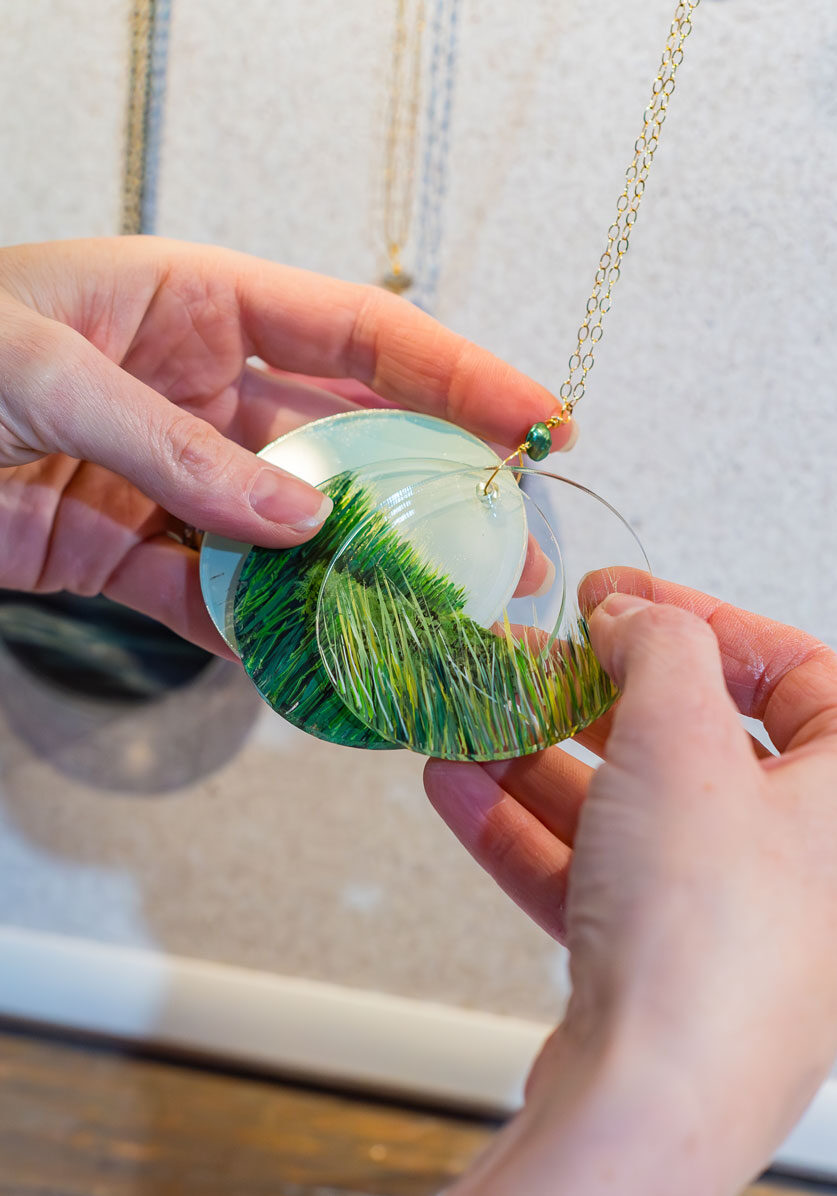Artist Jess Hurley Scott turned dyslexia into her “superpower,” allowing her to paint spectacular seascapes in layers.
By Jennifer H. McInerney
Photography by Kjeld Mahoney

Though she’s not a surfer, Scituate artist Jess Hurley Scott frequently dons a wetsuit and plunges into the roiling waves at local beaches. But instead of hopping on a surfboard, she points her GoPro waterproof digital camera at the swells rising above her head, capturing the peak of a wave as it crests and breaks, curling and peeling, tossing froth in its wake.
On a recent morning in the aftermath of a late-season Nor’easter, Scott discovered that “the action was good” at three of her favorite nearby spots: Peggotty, Egypt and Minot beaches in Scituate.
“When I’m photographing waves, I’m looking for energy, force, and shape, but also color and texture,” Scott explains.
From her up-close vantage point, she’s able to focus on the unique force and power—as well as the distinctive beauty—of the ocean’s motion, which she ultimately transforms into a three-dimensional painting on her easel.
“It’s easy to understand a seascape or a landscape because we’re very familiar with looking at them,” she says. “But I like presenting them in a different way and challenging how we perceive things.”
To create her 3-D images, Scott actually paints in reverse, layering three individual acrylic panels that come together to form a whole, comprising the background, middle ground and foreground. Painting in separate layers, rather than on a single flat canvas, enables her to build depth, add texture, and amplify details, resulting in dynamic and lifelike depictions.

The finished product, which she assembles by hand, appears at first glance to be a photograph. But viewed from the side, the routed acrylic panels she has layered on top of each other clearly show the color and contrasts of the paint and even the brush strokes.
“It’s something I came up with, through trial and error, about 20 years ago,” she says.
While working in product design for Tommy Hilfiger in New York City, Scott took a nude figure class in the evenings to continue working on her painting skills. The teacher, sensing that nudes were not her preferred medium, asked to see some of the landscapes she’d been painting on her own. When she showed him her experimental multi-layered works of waves and water, he fatefully said, “Whatever this is, keep doing this.”


“This validation sort of gave me permission to explore this medium and keep playing around with it,” she recalls.
Scott also attributes her success at this specific style of painting to the dyslexia she has lived with since childhood. While dyslexia is defined as a learning disorder, as an artist, “It’s my superpower,” she asserts. Her experience using graphic design programs such as Adobe Illustrator and Photoshop has also helped her with layering.
When she teaches children’s workshops, Scott makes sure to point out how dyslexia allows her to paint in reverse and not necessarily in sequence, which enables her to create her vibrant paintings.
“I’m a visual learner. I think that’s why I became an artist,” she notes. “I’ve always looked at painting structurally, like a sculpture.”
In 2019, Scott began a teaching residency for South Shore Art Center in Cohasset, presenting art lessons that connected the science of waves with artistic techniques to 1,500 South Shore students at area public and charter schools. When the pandemic shut down the schools, the art lessons continued on Zoom (with art materials mailed home to participating students), followed by a hybrid year of online and in-person teaching.


“I always talk about my dyslexia with the students because it’s important for them to understand that not everyone learns things the same way. They can find different ways of learning that work for them.”
Scott’s signature three-layer approach clearly works well for her. Over the past two decades, she has painted hundreds of pieces, each one taking 10 to 70 hours to complete, depending on the size. Her larger-scale works measure up to six feet.
Due to the nature of the acrylic panels, strategic lighting—whether in a gallery or in a home—can further enhance her paintings’ effects. “It’s like stained glass: the more you light it, the more the color changes.”
Her work can be viewed year-round locally at Bia Bistro in Cohasset, Coastal Chic Interiors in Norwell, and Untold Brewing’s taproom in Scituate, as well as at the Woodward Gallery in New York City and the James Baird Gallery in Newfoundland, Canada.
This spring, “Here and There,” a diptych she painted of waves at Minot Beach, will be featured in a group exhibit called “Where Do We Come From? What Are We? Where Are We Going?” at the Art Complex Museum in Duxbury, beginning that is running through September 1. Presented by the National Association of Women Artists, this juried show highlighting only women artists responds to a series of questions originally posed by artist Paul Gauguin.
For the month of June, Scott will join seven other artists at an invitational residency in Newfoundland, where she will devote her creative energies to her larger-scale seascapes. Of course, she’ll probably also spend some of her time outside the studio, most likely in her wetsuit, capturing some of Newfoundland’s finest waves with her waterproof camera for future projects.
At the conclusion of the month-long residency, works produced by Scott and her peers will be showcased in “Water,” an Exhibition of International Residency Artists at Pouch Cove Foundation at the James Baird Gallery in Newfoundland, on display from June 29 to July 27.
For additional information about
Jess Hurley Scott and her artwork, visit jesshurleyscott.com.
